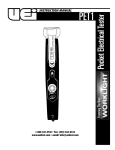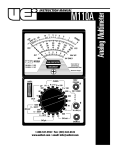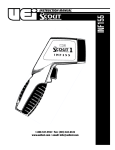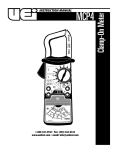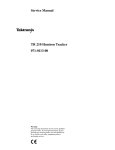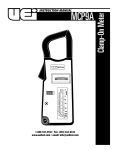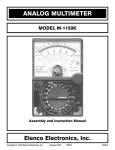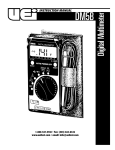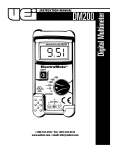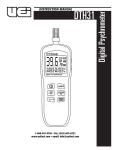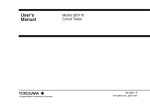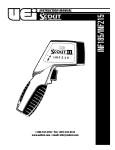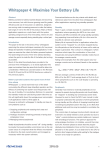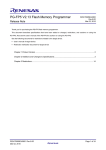Download INSTRUCTION MANUAL
Transcript
INSTRUCTION MANUAL M75A 1-800-547-5740 • Fax: (503) 643-6322 www.ueitest.com • email: [email protected] Introduction The M75A has the features you need for testing electrical and HVAC/R systems. Its voltage ranges are scaled to keep typical readings in the middle of the scale for increased accuracy and resolution. It also includes a low ohm scale to test critical connections as well as microamps and millivolts functions to verify heat anticipator and flame safeguard circuits. Features include • 17 ranges • 1000 Volts AC and DC • Resistance 50 kilohm • DC micro/milli amps • DC millivolt scale allows use of adapters • Color-coded and mirrored scale plate 3. Mechanical Zero Adjust: Is a plastic screw located on the meter face just beneath the green “FUSE PROTECTED OHM CIRCUIT” label. This adjustment is used to set the pointer to the zero index mark at the left side of the scale plate. 4. Input Jacks: COM (-): The black test lead is used to connect this jack to the negative, or common, side of the circuit under test. VΩM (+): This adjustment is used to set the pointer to the zero index mark at the left side of the scale plate. Operating Instructions WARNING! Observe all safety precautions when measuring higher voltages. Turn off power to the circuit under test. Set the M75A controls, connect the test leads to the meter and then to the circuit under test. Reapply power. If the pointer does not move, make sure that the protective fuse is not open. Safety Notes Before using this meter, read all safety information carefully. In this manual the word "WARNING" is used to indicate conditions or actions that may pose physical hazards to the user. The word "CAUTION" is used to indicate conditions or actions that may damage this instrument. Color Coding The meter scale plate and front panel are color coded. The DC Voltages and DC Current meter scale and “SELECTOR” switch positions are in black. The OHMS meter scale and “SELECTOR” switch positions are in green. The AC Voltage meter scales and “SELECTOR” switch positions are in red. Controls and Indicators 3 2 1 4 To provide an uncrowded easy-to-read meter scale plate a single meter scale may be used for more than one position of the “SELECTOR” switch. For example, the meter scale numerals 0 - 50 are used for the following positions of the “SELECTOR” switch: 50V DC, 50µA DC, 50V AC and 500V AC. To take a reading at any of the above “SELECTOR” switch positions the 0 - 50 scale numerals are either read directly or divided by 10. Example: (1) If the “SELECTOR” switch is set on 50V DC then read the numerals directly. (2) If the “SELECTOR” switch is set on 500V AC then multiply the 0 - 50 numerals by 10 (this will give a scale of 0 - 500). Measuring DC Voltage Set the “SELECTOR” switch to the appropriate range. Always start with the 1000V DC position if unsure of the magnitude of voltage present. Connect the black test lead to the “COM” jack and to the negative side of the circuit under test. Connect the red test lead to the “+VΩM” jack and to the positive side of the circuit under test. Read the voltage on the black meter scale corresponding to the “SELECTOR” switch setting. Note: the 250mV DC and the 50µA DC readings are taken at the same position of the “SELECTOR” switch. 1. Selector Switch: Is used to select the circuit function and range. it is good practice to start with the highest range setting of the selector switch for a particular function if the magnitude of the function is unknown. 2. ΩADJ: Is used only on the OHMS function. The purpose of this control is to calibrate the M75A on the particular range selected (Rx1, Rx10, etc.) M75A-MAN P. 1 Measuring DC Current Set the “SELECTOR” switch to the appropriate range. Always start with the 250 mA DC position if unsure of the magnitude of current present. When taking current measurements the meter must be connected in SERIES with the circuit, or circuit element, under test. Break the connection at which current is to be measured. Place the M75A in series with the circuit be connecting the black test lead to the “COM” jack and to the lower voltage side of the circuit. Connect the red test lead to the “+VΩM“ jack and to the higher voltage side of the circuit. Read the current on the black meter scale corresponding to the “SELECTOR” switch. The symbol “µ” is the standard symbol for the word “MICRO”. Hence, 50 µA DC = 50 DC microamp. Measuring Resistance WARNING! Remove all power to the circuit under test when making resistance measurements. If any voltage is present in the test circuit an erroneous reading will result and the 1/4A fuse may open. Set the “SELECTOR” switch to the appropriate range. Connect one test lead to the “COM” jack and the other test lead to the “+VΩM“ jack. Touch the free ends of the test leads together. The pointer will swing to the right hand side of thee scale. Adjust the “Ω ADJ“ control until the pointer is set on the green numeral 0. (Note: If this adjustment cannot be made refer to the “MAINTENANCE” section). Re-zero the M75A each time the OHMS setting of the “SELECTOR” switch is changed. To make the resistance measurement, connect the free ends of the test leads across the element to be measured. The measured resistance value will be the green numeral indicated on the OHMS scale times the multiplier on the “SELECTOR” switch. For example, if the pointer is on the numeral 4, and the “SELECTOR” switch is set on Rx 10, the resistance is 40 ohms (4Ω x 10 = 40Ω). Continuity tests are normally made to test a wire, or element, to see if it is unbroken. Because continuity tests involve low values or resistance, the “SELECTOR” switch should be set on the Rx1 position. Testing Diodes / Transistors A simple check of diode or transistor quality may be made with the M75A. Using the same test procedure as for measuring resistance, connect one test lead to one end of the diode and the other end of the diode. Note the resistance reading. Then reverse the test leads and again note the reading. If the two readings differ by a factor of ten then the diode, (or transistor junction) is probably good. If the readings are approximately the same then the diode is shorted. If a reading cannot be obtained in either direction, the diode is probably open. Transistor junction measurements should be taken between the base and emitter leads, or between the base and collector leads. Measuring AC Voltage Set the “SELECTOR” switch to the appropriate range. Always start with the 1000V AC position if unsure of the magnitude of voltage present. Connect the test leads to the “COM” jack and the “VΩM“ jack and to the circuit under test. Read the voltage on the red meter scale corresponding to the “SELECTOR” switch setting. M75A-MAN Maintenance Periodic Service WARNING! Repair and service of this instrument is to be performed by qualified personnel only. Improper repair or service could result in physical degradation of the meter. This could alter the protection from electrical shock and personal injury this meter provides to the operator. Perform only those maintenance tasks that you are qualified to do. These guidelines will help you attain long and reliable service from your meter: • Calibrate your meter annually to ensure it meets original performance specifications • Keep your meter dry. If it gets wet, wipe dry immediately. Liquids can degrade electronic circuits • Whenever practical, keep the meter away from dust and dirt that can cause premature wear • Although your meter is built to withstand the rigors of daily use, it can be damaged by severe impacts. Use reasonable caution when using and storing the meter Cleaning Periodically clean your meter’s case using a damp cloth. DO NOT use abrasive, flammable liquids, cleaning solvents, or strong detergents as they may damage the finish, impair safety, or affect the reliability of the structural components. Battery Replacement The purpose of the batteries is to supply power to the circuit under test while making resistance measurements. Eventually the batteries will age to the point where it will not be possible to zero the meter with the “ΩADJ” control. When this happens the batteries should be replaced. The two 1.5V size “AA” batteries are used only on the Rx1, Rx10, and Rx100 setting of the “SELECTOR” switch and should be replaced as a pair. Observe the proper battery polarity when replacing batteries. It is recommended that all batteries be removed if the M75A is not to be used for a long period of time. Remove the single screw in the rear of the case for access to the batteries. Fuses The 1/4A, 2.0 ohm, fuse is in series with the “+VΩM“ input jack. If this fuse is open none of the circuit functions will work. When replacing the fuse be sure to replace it with a fuse of the same current rating and internal resistance. The use of a fuse with a different internal resistance may cause the accuracy of the OHMS scale to be off. Remove the single screw in the rear of the case for access to the fuse. Mechanical Zero Adjustment The pointer is set to register 0 at the left hand edge of the scale when there is no input to the M75 and it is laying face up on a flat surface. If the pointer does not register 0, it may be reset to that position by carefully adjusting the plastic screw in the meter face, just below the green “FUSE PROTECTED OHMS CIRCUIT” label. P. 2 Specifications Ranges DC Millivolts DC Volts DC Microamps DC Milliamps OHMS AC Volts Temperature Accuracy DC OHMS AC Temperature General Input Impedance Batteries Fuse 0 - 250 mV 0 - 2.5, 10, 50, 250, 1000 V 0 - 50 µA 0 - 25, 250 mA 0 - 500Ω, 5K, 50K 0 - 10, 50, 250, 500, 1000 V 0 - 250˚F ±3% of full scale ±3% of scale length ±4% of full scale ±2 divisions 20KΩ / V DC, 10KΩ / V AC Two 1.5V, size AA (NEDA #15D) batteries 1/4A (2.0 ohm internal resistance) 3AG series Note: To maintain calibration accuracy and instrument protection, replacement fuse must be of the proper current and resistance value. Standard and Optional Accessories Standard Test leads (set) . . . . . . . . . . . . . . . . . . . . . . . . . . . . . . . . . . . . . . .ATL3 Test leads, rubber . . . . . . . . . . . . . . . . . . . . . . . . . . . . . . . . . . . . .ATL25 Alligator clip adapters . . . . . . . . . . . . . . . . . . . . . . . . . . . . . . . . . .AAC Fuse 1/4A, 2Ω . . . . . . . . . . . . . . . . . . . . . . . . . . . . . . . . . . . . . . . .AF2 Battery 1.5V, size AA . . . . . . . . . . . . . . . . . . . . . . . . . . . . . . . . . . .AB1 Optional Temperature adapter . . . . . . . . . . . . . . . . . . . . . . . . . . . . . . . . . .TA2K M75A-MAN P. 3 M75A Analog Multimeter Limited Warranty The M75A is warranted to be free from defects in materials and workmanship for a period of three years from the date of purchase. If within the warra n ty period your instrument should become inoperative from such defects, the unit will be repaired or replaced at UEi’s option. This warra n ty covers normal use and does not cover damage which occurs in shipment or failure which results from alteration, tampering, accident, misuse, abuse, neglect or improper maintenance. Batteries and consequential damage resulting from failed batteries are not covered by warra n ty. Any implied warranties, including but not limited to implied warranties of merchantability and fitness for a particular purpose, are limited to the express warranty. UEi shall not be liable for loss of use of the instrument or other incidental or consequential damages, expenses, or economic loss, or for any claim or claims for such damage, expenses or economic loss. A purchase receipt or other proof of original purchase date will be required before warra n ty repairs will be rendered. Instruments out of warra n ty will be repaired (when repairable) for a service charge. Return the unit postage paid and insured to: 1-800-547-5740 • FAX: (503) 643-6322 www.ueitest.com • Email: [email protected] This warranty gives you specific legal rights. You may also have other rights which vary from state to state. PLEASE RECYCLE Copyright © 2007 UEi M75A-MAN 1/07





